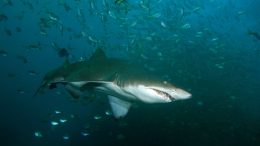In conservation reporting and advocacy, including mine, you’ll often see articles or experts cite statistics and figures that discuss the global state of groups of species like sharks, primates, orchids, or corals over years or decades.
Have you ever wondered, “how do scientists know that?”
A recent report from the IUCN Species Survival Commission’s Shark Specialist Group offers some insight — not just on the global status of sharks (TL:DR — it’s bad) but on how researchers and conservationists come to understand how well other large groups of related but widely distributed species are faring in the modern world.
The report, “The global status of sharks, rays, and chimaeras,” is a staggering work of conservation science. It synthesizes everything we know about the current conservation status of over 1,000 species of these amazing animals, organized at both the global scale and by country and region. It took 353 shark science and conservation experts from 158 countries — all volunteers — nearly two years to write. It’s also a case where the “behind the scenes” story of how it was made tells us much about the current state of the field.
So What Did They Find?
The latest shark conservation statistics are striking.
“We knew that worldwide, 37% of all species are threatened with extinction, but one of the things that came up writing this report was the number of species threatened at the country level,” says Rima Jabado, the chair of the IUCN SSC Shark Specialist Group and the lead author of the report. For some countries it was up to 70% of all local species.
View this post on Instagram
The report also revealed how much we don’t know: We just don’t have the kind of reliable data needed to track population trends for far too many species of concern in far too many countries, so the real figures may be even worse.
Additionally, those numbers are for the aggregate group of sharks and their relatives. Jabado stressed that rays are more threatened than sharks, and chimeras lack a lot of data.
The report also found that the biggest threat to sharks and their relatives — by far — comes from unsustainable fishing practices. But the team cautions that this does not just refer to shark finning, despite that being the most common threat that many shark enthusiasts have heard of.
“An emerging thing we’re seeing is that the shark meat trade is growing,” says Alexandra Morata, the program officer for the SSG. “It’s not just fins, and we should care about sharks and their conservation, not just because of fins.”
On top of the threats, the report also found that as of the end of 2023 science has identified 1,266 species of sharks, rays, and chimeras, with more than one-quarter of those species described since the start of the 21st century. This taxonomy research is vital to underpin conservation efforts — after all, we can’t understand how threatened a species is or how to protect it if we don’t know that it even exists.
These might seem like some pretty clear assessments. But getting to these conclusions presented some challenges — and required a clear vision and a lot of hard work and sacrifice.
How Did Leaders Get So Many People in So Many Different Places to Work Together for So Long?
Part of the answer was a clear vision for a useful product.
“People felt there was a lot of value in having a report with information at the country level when you want policymakers to read something about their own country and take action,” says Jabado. “We wanted a one-stop shop where you can find any information that you want about sharks, rays, and chimaeras at the country level, written in a way that anyone could understand it.”
The IUCN has a known track record of producing useful, actionable products like this — while some other conservation organizations have a reputation for shouting into the void without getting much done. It can be easier to get people to contribute when they know the end product has a clear chance of making a real difference.
View this post on Instagram
Another part of the answer is a sense of shared mission of the organization and a shared love of sharks and their conservation.
“People believe in the mission of the Shark Specialist Group, they love to contribute to [its] work, and they love to get together to do that,” says Nick Dulvy, a marine ecologist at Simon Fraser University and the former co-chair of the specialist group. “Funders don’t want to work with a fractious, divided, territorial scientific community. The growth of the shark conservation science community has been, in part, by its collegiality and willingness to cooperate and put considerable amounts of volunteer time into attending Red List workshops.”
How Do You Co-Write a Report With So Many People?
The SSG is one of the largest of the Species Survival Commission’s specialist groups, and it’s organized into global regions, each with their own regional vice chair or chairs.
“We communicated with our regional vice chairs a lot, and they helped to herd scientists in their respective regions,” says Morata. “We also hosted a series of regional in-person workshops that allowed local experts to meet and contribute, and then a small additional workshop just for overall report editors. By the time the report got to about 2,000 pages, I was basically living on chocolate and coffee.”
In cases where an in-person workshop wasn’t an option, the answer was long Zoom calls, often at inconvenient times for someone.
“We needed to get the Caribbean people together for six hours,” says Jabado, who is based in Dubai. “But day for them meant night for me here. It was the middle of the night in some cases, but I accepted it. Everybody sacrificed eventually along the way.”
Getting so many people from all over the world to contribute to a cohesive product that is still useful at the country level also required some flexibility with formatting — essentially letting each regional team write their sections in a way most useful to them.
“We gave them headings, and we wanted things structured overall, but we allowed it to flow however they thought would work best,” says Jabado. “They know their countries best.”
Another challenge was language. Although the report is in English, that’s not the first language for many of the contributors. Morata and Jabado spent a great deal of time carefully rephrasing text and going back and forth with contributors, taking care to make sure that what was written reflected what the authors were really trying to say.
Some Advice
For conservation science colleagues trying to engage in a similar large project, Jabado has some hard-won advice to share.
“Engage with as many people as you can, be open to suggestions, and be patient,” she says. “This will take longer than you plan, and in some cases you’ll have people finishing their chapters…and waiting [two years] for it to be published because 100 other countries haven’t finished their chapters yet.”
View this post on Instagram
Overall, despite logistical complications in writing such a large report, the team says they are thrilled with the output.
“We wanted to translate all the science into something a bit more tangible and accessible,” says Jabado. “And in a lot of countries, a lot of people are already using it to engage with their government.”
That means the report is already helping sharks and their relatives “on the ground.” Scientists, meanwhile, have clear marching orders: Fill in those data gaps the report revealed.
And of course, all this work sets the stage for the next big update — although the team may take a couple of years off before they do this again.


Previously in The Revelator:
The Curlew, the Cactus, and the Obliterated Whitefish: The Species We Lost in 2024


